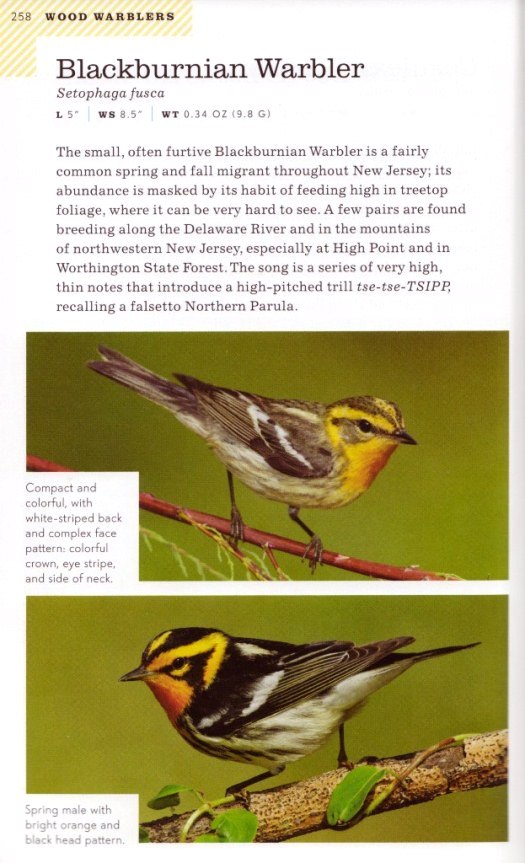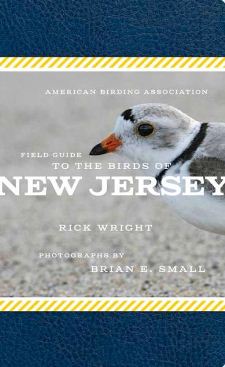Reviewed by Grant McCreary on May 15th, 2014.
I don’t like state field guides. I should clarify – I have nothing against the concept, it’s just that the execution has been lacking. I had only seen one that I thought was worth having*. So I was very curious when I saw that the American Birding Association was going to start a line of such guides. I think the ABA is a great organization and the authors they had lined up are all great birders and writers who should know what makes a good field guide. So I was cautiously optimistic when I received the first book in the series, Rick Wright’s American Birding Association Field Guide to Birds of New Jersey.
Most state field guides are targeted to new birders. The problem is that the authors usually err on the side of simplicity, presumably thinking that new birders can’t handle too many options. These guides include too few birds, just one (or maybe two) illustrations per species, and often organize species in a non-standard way (such as by color, habitat, or size). The most frustrating thing for any birder is to see a bird and not be able to find a likely match in their field guide. And not depicting all the likely birds or enough variation within species is a good way to make sure that happens.
Although this ABA New Jersey guide is intended for new to intermediate birders, it doesn’t succumb to the aforementioned pitfalls. The 255 species included are all the regularly occurring ones likely to be seen, organized more-or-less taxonomically. And each is shown in 1-3 beautiful photographs, most of which were taken by Brian E. Small, one of the foremost North American bird photographers.
These photos are large and well-reproduced. More importantly, various plumages are included. Male and female are usually shown when different, as are some seasonal plumages and juveniles (I can’t believe how many field guides don’t show juvenile cardinals!). I was surprised, though, that only male Downy and Hairy Woodpeckers are depicted and that nowhere in the species accounts is it mentioned that the females lack the red nape patch. Similarly, two photos of White-throated Sparrow are included, but both show white-striped individuals (although in this case one of the captions does mention that the stripe can be white or tan). Every user is bound to have quibbles such as these, but for the most part the variation shown is sufficient. I was also pleased at the number of in-flight photos, with all of the raptors and swallows, along with many of the waterfowl, herons, shorebirds, gulls, terns, and even owls shown flying.

The species accounts are one or two pages, with about half a page of that for text. Length, wingspan, and weight are given first. Then Wright briefly describes the bird and any relevant behaviors and natural history. Its status and distribution is summarized, often with mention of the best places in the state to look for it. For migrants, this includes the months of arrival and departure. Finally, the song and call are described. Each of the photos is also captioned with identification-related information.
This adds up to a considerable amount of text in each account. But I’d recommend that it all be read carefully, as a lot of useful information is packed into it. If you want to learn how to recognize the bird, start with the photo captions, but don’t stop there as you’ll also find relevant information in the main body of text. Even more information is scattered throughout the book in the form of sidebars; most dealing with identification of difficult groups such as ducks, raptors, shorebirds, thrushes, and sparrows. While these are all very useful, presenting additional tips that couldn’t fit into the individual species accounts, my favorite is the one on “farm country birds”. It explains the difficulties faced by open-country birds in today’s world, as exemplified by the Upland Sandpiper and Henslow’s Sparrow, two now-rare breeding birds of New Jersey. I wish more field guides would include such things; as Birds of New Jersey proves, you can present conservation-related messages in a relevant manner. It might just help new birders care about more than just identifying birds.
A 34-page introduction includes the usual sections on how to use the guide, bird topography, and the like. The birding sites mentioned in the text are all listed here as well, along with the best seasons to visit and the types of birds you’re likely to see. The inside-front cover has a detailed map of the state, with counties, cities, and birding sites shown. The last page has a helpful quick index.
One thing that you won’t find in this field guide is range maps. I was disappointed at first; I like to have range maps even in state field guides. However, the text does a good job of describing where and when the bird can be found. And to show maps in great enough detail to be useful, the photos or text would have to be compromised. Besides, such maps already exist – in William Boyle’s The Birds of New Jersey: Status and Distribution. I would strongly urge getting that book as a companion to this field guide.
One last thing, something that I don’t usually mention – I love the binding! The cover is made from a textured, somewhat flexible material that gives the guide a distinguished look. Plus, it seems like it will be very durable. Along with a not-full-length jacket, it recalls the binding of the Audubon field guide series, but better.
Recommendation
American Birding Association Field Guide to Birds of New Jersey is a state field guide that I can actually recommend. It’s a great choice for newer birders in the Garden State, as it includes most of the birds likely to be seen and information specific to the state in a portable, attractive format. This is a great opening act for the American Birding Association state field guide series, which will continue with a volume on Colorado coming in June, and then Florida and Massachusetts later this year.
* Birds of Georgia, from Lone Pine Publishing. Lone Pine has an extensive line of state and regional guides, but I don’t know if the rest are worthwhile. Back to top
Disclosure: I get a small commission for purchases made through links in this post.
Buy from NHBS
(based in the U.K.)
Disclosure: The item reviewed here was a complementary review copy provided by the publisher. But the opinion expressed here is my own, it has not been influenced in any way.






[…] :: From Grant at The Birder’s Library: American Birding Association Field Guide to Birds of New Jersey […]
[…] :: From Grant at The Birder’s Library: American Birding Association Field Guide to Birds of New Jersey […]
Useful info. Fortunate me I found your web site unintentionally,
and I am surprised why this accident did not took
place in advance! I bookmarked it.
I am really loving the theme/design of your web site.
Do you ever run into any web browser compatibility issues?
A few of my blog audience have complained about my blog not working
correctly in Explorer but looks great in Firefox.
Do you have any recommendations to help fix this
problem?